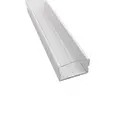Tile Seal Strip Solutions for Effective Water Protection and Enhanced Durability
Dec . 01, 2024 21:35 Back to list
Tile Seal Strip Solutions for Effective Water Protection and Enhanced Durability
Understanding Tile Seal Strip Products An Essential Guide
Tile seal strip products serve a vital role in the maintenance and longevity of various flooring systems. When it comes to enhancing the aesthetics and functionality of tiled surfaces, these products have established themselves as a fundamental choice among homeowners and professionals alike. In this article, we will explore what tile seal strip products are, their benefits, types, and installation processes, providing a comprehensive understanding of their significance.
What Are Tile Seal Strip Products?
At their core, tile seal strip products are materials designed to seal the gap between tiles and adjacent surfaces, such as walls, other flooring materials, or even plumbing fixtures. They are typically made from durable materials like rubber, silicone, or polyurethane, which are chosen for their ability to resist moisture, complete imperfections, and enhance the overall aesthetic appeal of tiled areas.
Benefits of Tile Seal Strip Products
1. Moisture Protection One of the primary functions of seal strips is to prevent moisture from seeping between tiles. This is especially important in areas like bathrooms and kitchens where water exposure is frequent. By minimizing water infiltration, seal strips help prevent mold and mildew growth, which can lead to serious health issues and structural damage.
2. Improved Aesthetics Tile seal strips can greatly enhance the visual appeal of tiled surfaces. Available in various colors and finishes, these strips can complement or contrast with the tiles, adding a polished and professional look to the installation.
3. Noise Reduction Many tile seal strip products also provide sound-dampening properties. They help reduce the echo and noise transmission from foot traffic, making living spaces more comfortable and serene.
4. Flexibility and Movement Accommodation Buildings settle over time, and floors can shift. Seal strips provide flexibility to accommodate such movements, reducing the risk of cracking tiles or grout lines.
5. Easy Maintenance Seal strips typically require minimal maintenance. They can be wiped clean and do not require special cleaning agents, making them easy to care for in busy environments like homes or commercial spaces.
Types of Tile Seal Strip Products
Tile seal strips come in various types, each catering to specific needs and applications
1. Cove Base Trim This type is often used in commercial settings and is designed to adhere to the wall and floor, creating a smooth transition. They are effective in protecting wall edges from damage and preventing moisture buildup.
tile seal strip products

2. Silicone Seal Strips These are highly flexible and can conform to irregular surfaces. Silicone seal strips are commonly used in kitchens and bathrooms for their water-resistant properties.
3. Rubber Seal Strips Durable and resistant to wear, these strips are ideal for high-traffic areas. Rubber seal strips often provide sound insulation along with moisture protection.
4. Tile Transition Strips Used to transition between two different types of flooring, these strips can create a seamless look while accommodating different heights and surfaces.
Installation Process
Installing tile seal strips is a straightforward process that can be accomplished with basic tools. Here is a general outline of the steps involved
1. Preparation Ensure the surface is clean and free of dust or debris. Measure the length of the area where the seal strip will be applied.
2. Cutting the Strip Using a utility knife or scissors, cut the seal strip to the appropriate length. Make sure to create clean, straight edges for a neat finish.
3. Adhesive Application If the seal strip is adhesive-backed, peel off the protective layer. Otherwise, apply a strong adhesive suitable for the material of the strip to the back.
4. Placement Firmly press the seal strip into place, ensuring good adhesion. For additional security, you can use a roller to apply pressure along the entire length of the strip.
5. Finishing Touches Allow the adhesive to cure as per the manufacturer’s instructions, and remove any excess adhesive that may have squeezed out during installation.
Conclusion
Tile seal strip products are essential elements in protecting and enhancing tiled surfaces. With their myriad benefits ranging from moisture protection to improved aesthetics and sound reduction, they are undoubtedly a worthwhile investment for any tiled area. Whether you are a homeowner or a contractor, understanding the different types of seal strips and their applications can help you make informed decisions that contribute to the longevity and beauty of your flooring.
-
Premium Window Seal Strip Adhesive: Manufacturers & Suppliers
NewsAug.26,2025
-
Best Window Seal Strip Adhesive Companies: Strong, Durable Seals
NewsAug.25,2025
-
Karcher A2004 Wet & Dry Vacuum Filter: Premium Replacement Cartridge
NewsAug.24,2025
-
Premium Vacuum Filter for Karcher VC 4, VC 6, VC 7 & Tineco A10, A11
NewsAug.23,2025
-
Hi-Flo HF155 Oil Filter KTM 250 EXC Racing 03-06 | OEM 580.38.005.000
NewsAug.22,2025
-
Leading LED Neon Rope Light Outdoor Companies & Exporters
NewsAug.21,2025
